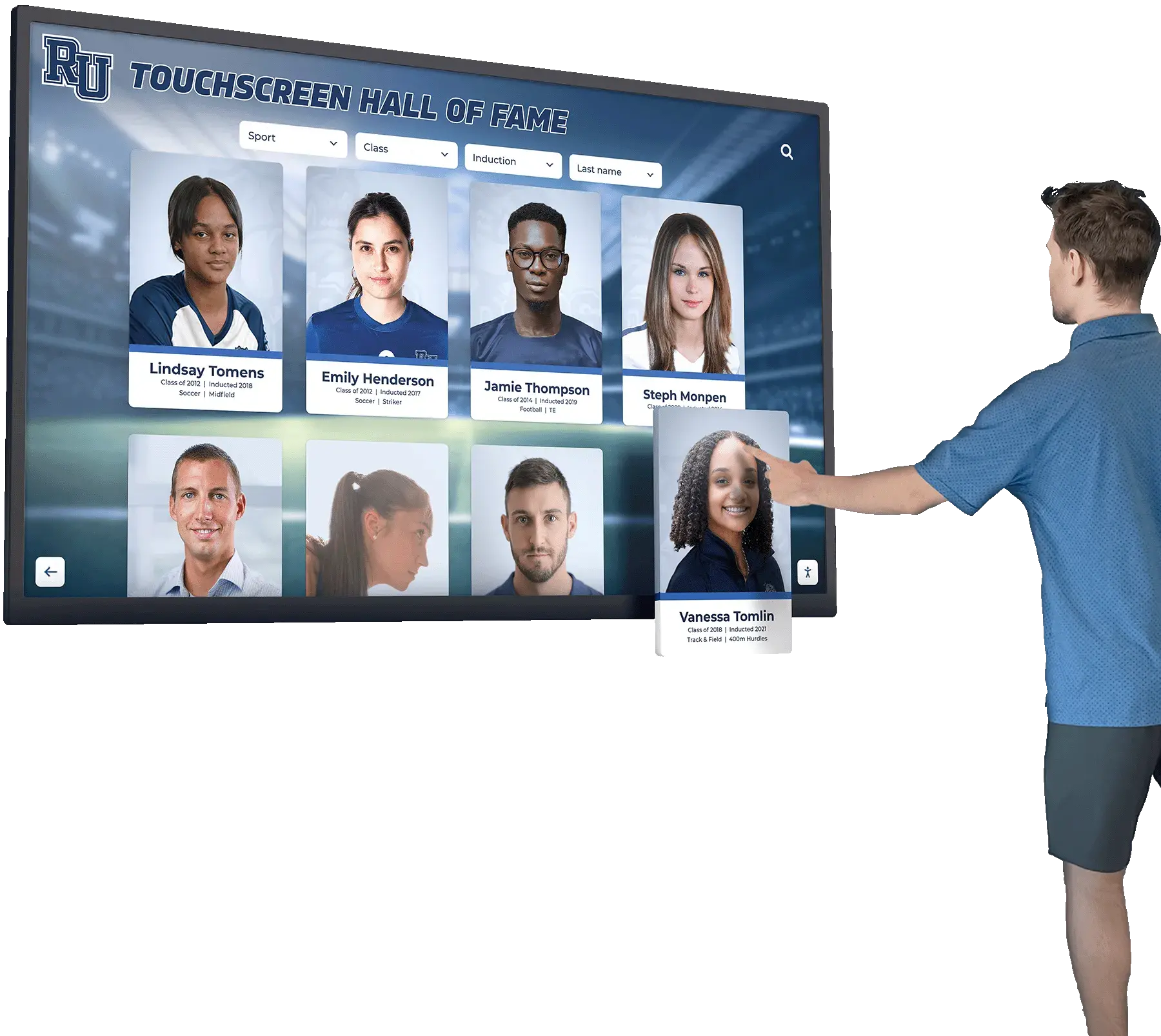Key Takeaways
Discover how digital recognition displays inspire alumni to give back, increasing donation rates 25%. Learn proven strategies that transform appreciation into lasting philanthropic support.
The Alumni Giving Challenge Facing Educational Institutions
Educational institutions depend heavily on alumni philanthropy to fund scholarships, support facilities, enhance programs, and maintain competitive excellence. However, cultivating sustained alumni giving has grown increasingly difficult in an era of competing priorities, digital distraction, and evolving donor expectations.
Understanding Current Alumni Giving Trends
According to recent research from the Council for Advancement and Support of Education (CASE), alumni giving participation has declined significantly over the past two decades. Many institutions struggle to maintain even 10-15% participation rates among their alumni base, while donor retention—the percentage of contributors who give again the following year—hovers around 40-45% nationally.
This revolving door of donors creates enormous fundraising challenges. Organizations must constantly acquire new donors to replace those who lapse, expending valuable resources on recruitment that could instead strengthen relationships with existing supporters. The financial mathematics prove stark: a 5% improvement in donor retention can increase lifetime donor value by 25-95%, making retention the most cost-effective fundraising strategy available.
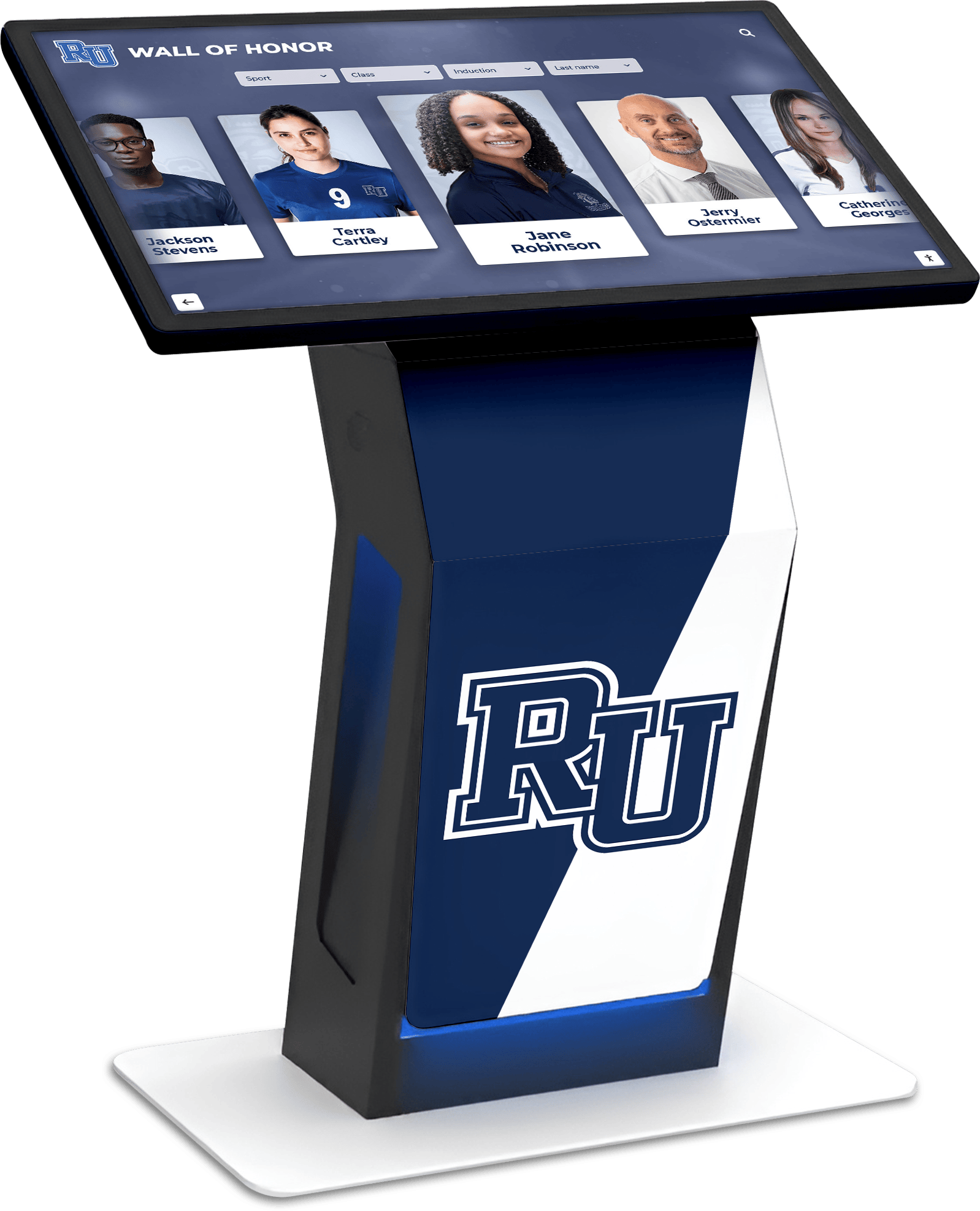
Why Traditional Recognition Falls Short
Traditional alumni recognition methods—static plaques, printed honor rolls, occasional newsletter mentions—face inherent limitations that undermine their effectiveness as giving motivators:
Limited Capacity and Visibility: Physical plaques fill available wall space within years, forcing difficult decisions about which alumni receive recognition. Static displays reach only visitors who happen to pass specific hallways, missing the vast majority of alumni who live far from campus or rarely visit facilities.
Minimal Engagement: Engraved names and graduation years provide no context about achievements, personal stories, or giving impact. This information poverty fails to create emotional connections that inspire others while inadequately honoring the contributors being recognized.
Update Barriers: Adding names to traditional displays requires ordering plaques ($150-400 each), scheduling fabrication and installation, and managing months-long timelines. These logistical barriers delay recognition, reduce currency, and create unsustainable ongoing costs.
No Analytics or Insights: Traditional methods provide zero data about recognition effectiveness, visitor engagement, or program impact. Without measurable outcomes, advancement teams struggle to justify recognition investments or optimize approaches based on actual behavior.
These limitations explain why many institutions’ recognition programs become afterthoughts rather than strategic fundraising assets. Modern challenges demand modern solutions—which is where digital recognition technology transforms possibilities.
How Digital Displays Create Psychological Giving Motivation
Understanding the psychological mechanisms through which digital displays inspire giving helps institutions design recognition programs that maximize fundraising impact. Research in donor psychology reveals several powerful motivations that effective digital recognition addresses directly.
Social Proof and Peer Influence
When prospective donors see others in their peer group contributing generously, it establishes charitable giving as expected, normal behavior within their community. Digital displays amplify this social proof through:
Visible Community Support
Comprehensive donor walls demonstrating broad alumni participation create powerful validation that encourages others to join philanthropic efforts
Giving Level Anchoring
Seeing gift ranges and giving societies establishes mental reference points for appropriate contribution amounts
Leadership Examples
Prominent alumni making major gifts inspire others to increase their own philanthropic commitments
Collective Impact Stories
Demonstrating how individual gifts combine to create transformational change motivates participation in larger missions
Research consistently shows that individuals are 3-5 times more likely to contribute when they observe peers making similar donations. Digital recognition makes this social proof continuously visible rather than confined to annual reports or occasional events, creating persistent influence on giving decisions throughout the year.
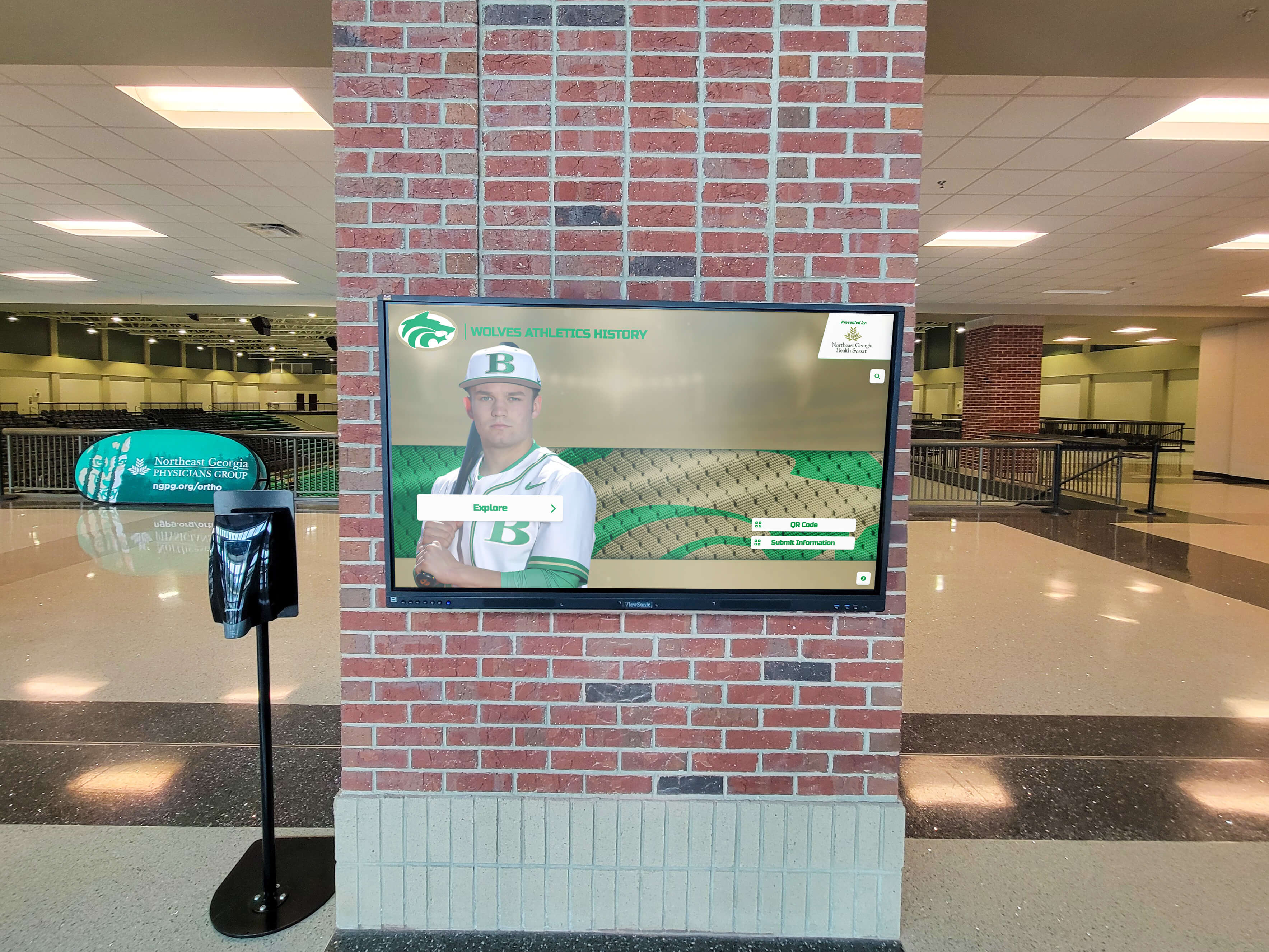
Identity Reinforcement Through Public Recognition
Public recognition affirms donors’ self-concept as generous, values-driven individuals committed to causes they care about. When contributors see their names among fellow supporters—particularly through engaging digital donor recognition displays—it validates their identity as philanthropists aligned with institutional missions.
This identity reinforcement creates stronger commitment than transactional exchanges alone could generate. Digital displays enhance identity reinforcement through:
Prominent Placement: High-traffic locations ensure regular visibility that repeatedly reinforces donor status and institutional connection
Personalized Profiles: Comprehensive biographical information, photos, and personal statements strengthen individual identity expression
Society Membership: Clear designation of giving societies, lifetime giving tiers, and consecutive years recognition creates aspirational identity categories
Peer Community: Seeing themselves among respected alumni, community leaders, and role models reinforces positive self-concept
Lasting Legacy: Permanent digital recognition provides symbolic immortality—contributions and values will endure beyond individual lifetimes
Reciprocity and Gratitude Cycles
Thoughtful donor recognition creates virtuous cycles where meaningful acknowledgment leads to continued giving, which generates additional appreciation, further strengthening relationships in self-reinforcing patterns. Digital displays enhance reciprocity through:
Immediate Satisfaction: Digital systems enable prompt recognition—sometimes within days rather than the months traditional displays require. This rapid acknowledgment creates positive associations with giving acts themselves.
Ongoing Appreciation: Unlike one-time thank-you letters that get filed away, digital displays provide continuous public recognition that donors encounter repeatedly during campus visits, special events, and virtual interactions.
Enhanced Visibility: Web-accessible recognition extends appreciation beyond those who visit physical facilities, ensuring all supporters receive acknowledgment regardless of geographic location or campus visit frequency.
Impact Documentation: Integrating giving recognition with scholarship stories, facility progress updates, and program outcomes demonstrates tangible results that validate donor investment and inspire continued support.
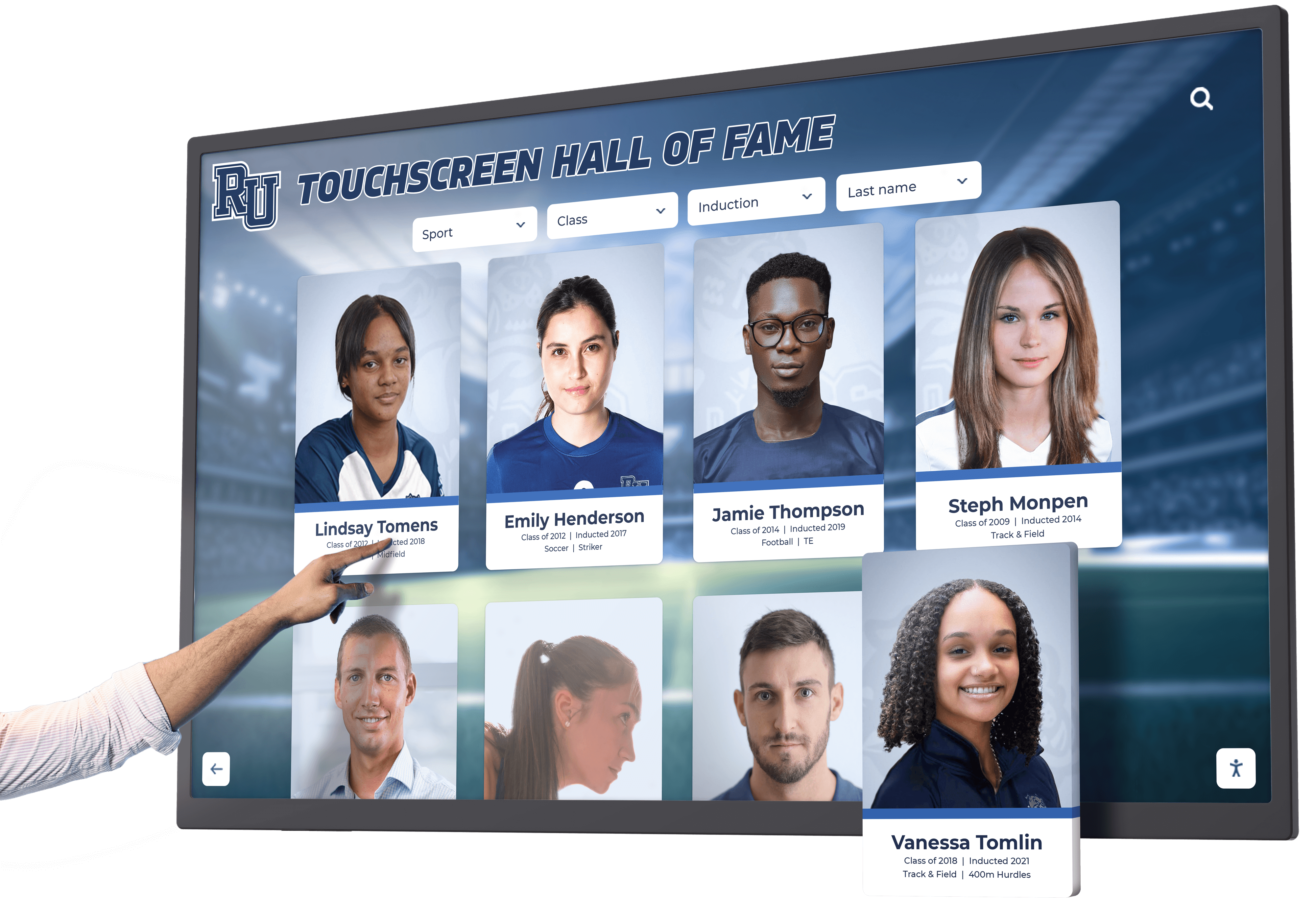
Organizations implementing comprehensive digital recognition programs report 40-60% better donor retention rates compared to those using minimal acknowledgment methods. This retention improvement alone generates significant lifetime value increases that typically justify recognition system investments within 18-24 months.
Proven Strategies: How Leading Institutions Use Digital Displays to Increase Alumni Giving
Successful institutions don’t simply install displays and hope for fundraising improvements—they implement strategic approaches that intentionally connect recognition to giving motivation. Here are the proven strategies generating measurable results:
Strategy 1: Create Comprehensive Recognition That Honors All Giving Levels
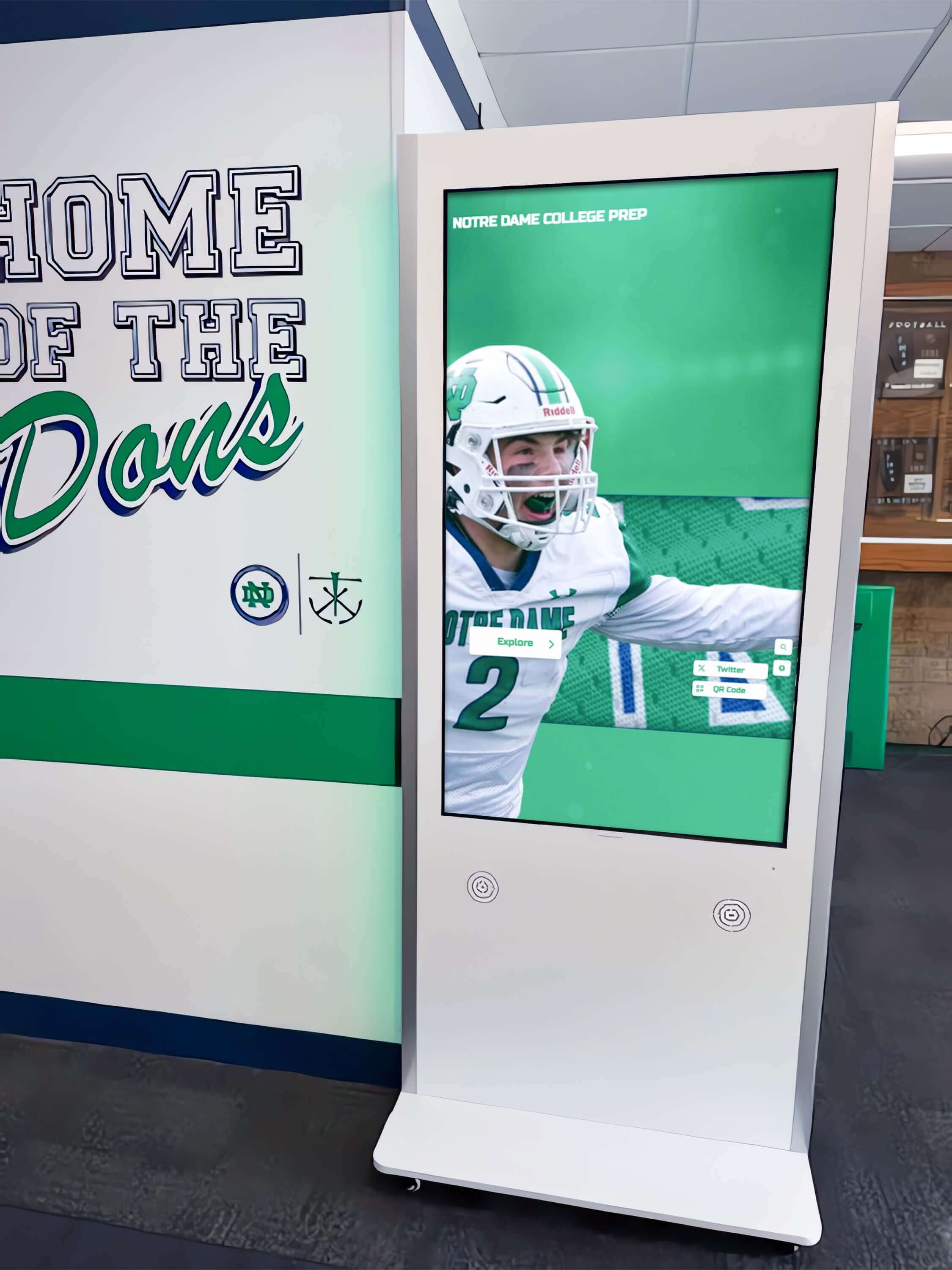
The most effective recognition programs acknowledge donors at every contribution level, from first-time $50 gifts to transformational seven-figure commitments. This inclusive approach serves multiple strategic purposes:
Broadens Participation: When alumni see that contributions of all sizes receive meaningful recognition, they feel welcomed into the philanthropic community regardless of current capacity
Encourages Upgrades: Clear visibility of different giving societies and recognition tiers creates natural upgrade motivation as donors aspire to reach higher acknowledgment levels
Demonstrates Values: Comprehensive recognition signals that institutions value generosity itself rather than just the largest gifts, strengthening emotional connections across the entire donor base
Builds Pipelines: Today’s $100 annual fund donors become tomorrow’s major gift prospects—comprehensive recognition maintains engagement during capacity-building years
Digital systems’ unlimited capacity enables this inclusive strategy impossible with space-constrained traditional displays. Leading institutions structure digital recognition with tiered profiles providing progressively enhanced acknowledgment at higher giving levels while ensuring all contributors receive appropriate appreciation.
Strategy 2: Tell Compelling Stories That Connect Giving to Impact
Generic recognition listing names and amounts fails to inspire emotional connections that motivate continued support. The most effective digital displays transform basic acknowledgment into compelling storytelling that demonstrates tangible outcomes enabled by alumni generosity.
Impact Visualization Strategies:
Scholarship Stories
Feature students receiving donor-funded scholarships, explaining how support made education possible and changed life trajectories
Facility Progress
Document renovation and construction projects with before/after comparisons, progress photos, and community impact descriptions
Program Outcomes
Showcase results achieved through donor-supported initiatives—students served, research published, competitions won, lives changed
Beneficiary Testimonials
Include video messages or quotes from program participants, scholarship recipients, and community members directly served by generosity
Donor Motivations
Share why contributors chose to give—personal connections, values alignment, desire to create opportunities they received or never had
Multi-Year Tracking
Document sustained impact over time, showing how initial gifts launched programs that continue producing outcomes years later
This impact-centered storytelling approach—detailed in research on highlighting donor recognition—transforms recognition from transactional acknowledgment into inspirational content that validates giving decisions while motivating prospective donors through concrete evidence that contributions create meaningful change.
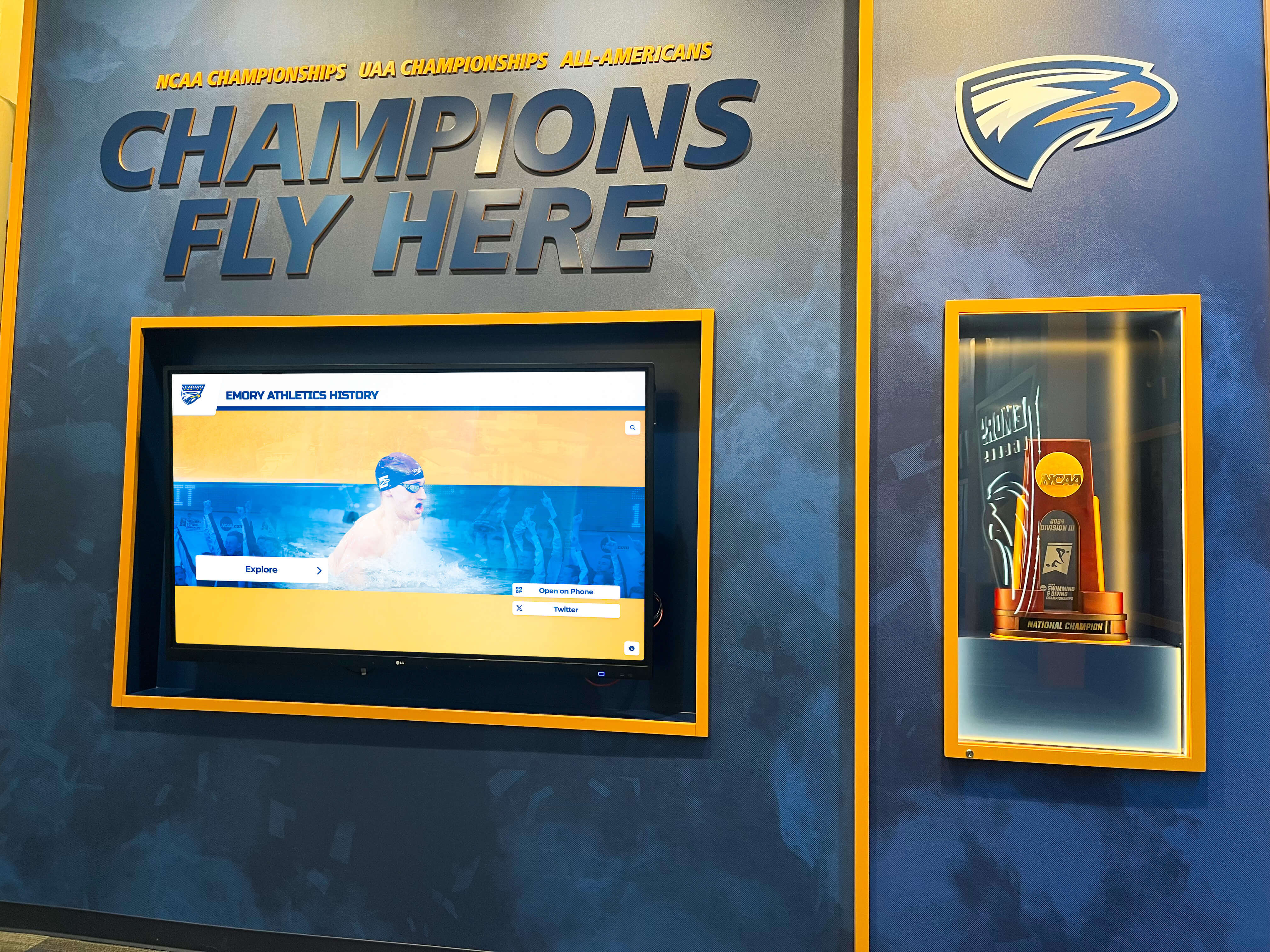
Strategy 3: Make Recognition Interactive and Discoverable
Static displays that visitors passively view generate minimal engagement compared to interactive experiences that invite exploration, personal discovery, and emotional connection. The most successful digital recognition systems incorporate features that dramatically increase interaction time and giving motivation:
Essential Interactive Features:
Powerful Search Functionality: Enable alumni to instantly locate themselves, classmates, teammates, or mentors through full-text search with auto-complete suggestions
Advanced Filtering: Allow visitors to discover alumni by graduation year, major, career field, geographic location, giving society, or achievement type
Related Content Connections: Automatically surface similar alumni profiles, common giving interests, or complementary stories that encourage continued exploration
Social Sharing Integration: Provide one-click sharing to Facebook, LinkedIn, and Twitter that extends recognition visibility exponentially beyond direct display visitors
Multimedia Presentations: Integrate professional photography, video testimonials, impact visualizations, and comprehensive biographical narratives impossible with static formats
Giving Opportunities: Include clear calls-to-action, QR codes for instant mobile giving, and information about how others can support similar initiatives
Research shows visitors spend 8-12 minutes exploring interactive digital displays compared to 30-60 seconds glancing at traditional plaques. This 10-15x engagement increase creates proportionally stronger emotional connections and giving motivation. For more on implementing engaging systems, explore resources on interactive alumni displays.
Strategy 4: Integrate Physical and Digital Recognition Ecosystems
The most sophisticated institutions create comprehensive recognition ecosystems connecting physical campus displays with web-accessible platforms, mobile applications, social media integration, and advancement communications. This multi-channel approach ensures recognition reaches alumni through their preferred platforms while maximizing visibility and engagement opportunities.
Physical Display Components:
- High-traffic campus installations in lobbies, athletic facilities, and advancement offices
- Event-specific displays during reunions, homecoming, and fundraising galas
- Strategic placement ensuring maximum exposure to visiting alumni and prospective donors
- Professional design reflecting institutional brand and recognition program excellence
Digital Extension Strategies:
- Web-accessible recognition portals enabling global alumni to explore content remotely
- Mobile-optimized platforms providing on-the-go access to profiles and giving opportunities
- Social media campaigns featuring different donors weekly or monthly
- Email newsletters highlighting recent recognition additions and updated profiles
- Advancement office tablets for showing recognition to prospects during cultivation meetings
This integrated approach—described in detail in guides on digital alumni recognition—extends recognition visibility far beyond single display locations while creating multiple touchpoints that strengthen donor relationships and giving motivation across diverse engagement channels.
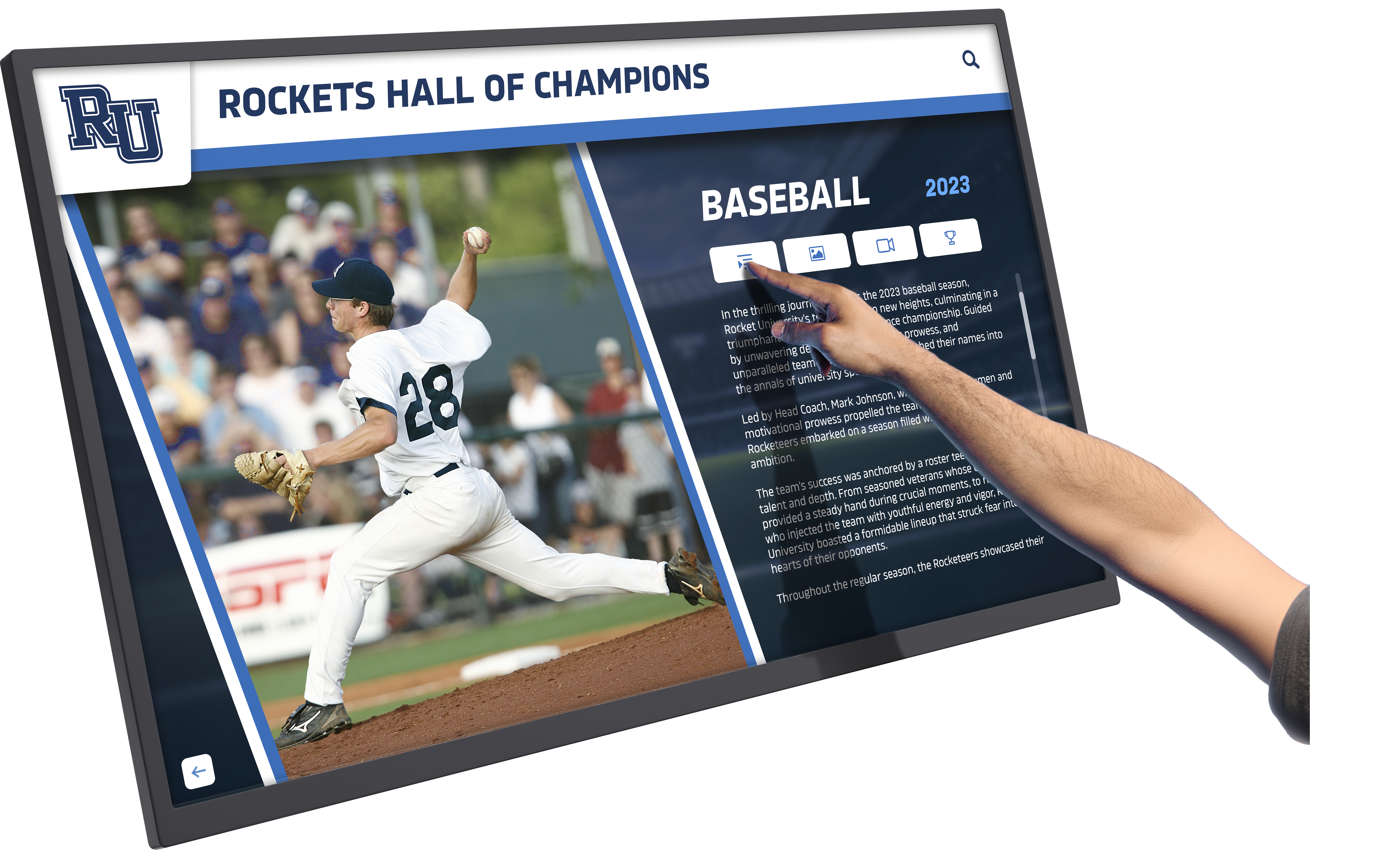
Strategy 5: Update Recognition Regularly to Demonstrate Momentum
Stale recognition displays that haven’t been updated in years send problematic messages about organizational vitality and fundraising success. Leading institutions maintain recognition currency through systematic update schedules that demonstrate active campaigns, growing support, and sustained institutional momentum.
Recognition Currency Best Practices:
Rapid New Donor Addition: Digital systems should add newly recognized donors within 48-72 hours of gift confirmation rather than waiting for quarterly or annual update cycles. This immediate acknowledgment creates strong positive associations while demonstrating responsive stewardship that encourages continued support.
Featured Content Rotation: Regularly rotate “featured donor” spotlights on display home screens, highlighting different contributors monthly or quarterly. This rotation ensures all recognition levels receive premium visibility while maintaining fresh content that encourages repeat visits.
Campaign Progress Visualization: During active fundraising campaigns, update progress metrics, campaign thermometers, and giving totals weekly or even daily. Real-time campaign tracking creates urgency and demonstrates momentum that motivates participation.
Impact Story Enhancement: Continuously collect and add new scholarship recipient profiles, facility progress photos, program outcome metrics, and beneficiary testimonials. Fresh impact documentation validates donor investment while inspiring additional support.
Milestone Recognition: Systematically celebrate donor anniversaries, cumulative giving thresholds, consecutive years of support, and giving society advancements. Milestone recognition creates ongoing touchpoints that strengthen relationships and retention.
Institutions treating digital recognition as dynamic, living platforms rather than static installations see significantly stronger fundraising outcomes compared to organizations implementing systems then neglecting ongoing content management.
Measurable Results: The Fundraising Impact of Digital Recognition
Data from hundreds of educational institutions implementing strategic digital recognition displays reveals consistent, measurable improvements across key fundraising metrics. Understanding these outcomes helps advancement teams justify recognition investments while setting realistic expectations for program performance.
Donor Acquisition and Participation Growth
Institutions launching comprehensive digital recognition programs report notable increases in overall giving participation:
First-Year Improvements:
- 15-20% increase in new donors compared to pre-recognition baseline
- 12-18% improvement in lapsed donor reactivation rates
- 25-35% higher giving participation among younger alumni (graduates from past 10-15 years)
- 10-15% increase in overall alumni giving participation rates
Sustained Long-Term Growth:
- Year-over-year participation improvements averaging 3-5% annually through years 2-5
- Expanded donor base providing larger pools for major gift cultivation
- Stronger giving cultures evident in improved peer solicitation success rates
- Higher first-time donor retention setting foundation for lifetime value growth
These participation improvements stem from multiple recognition-driven factors: social proof inspiring new givers, improved stewardship retaining first-time donors, enhanced visibility reaching previously unengaged alumni, and compelling storytelling that motivates action.
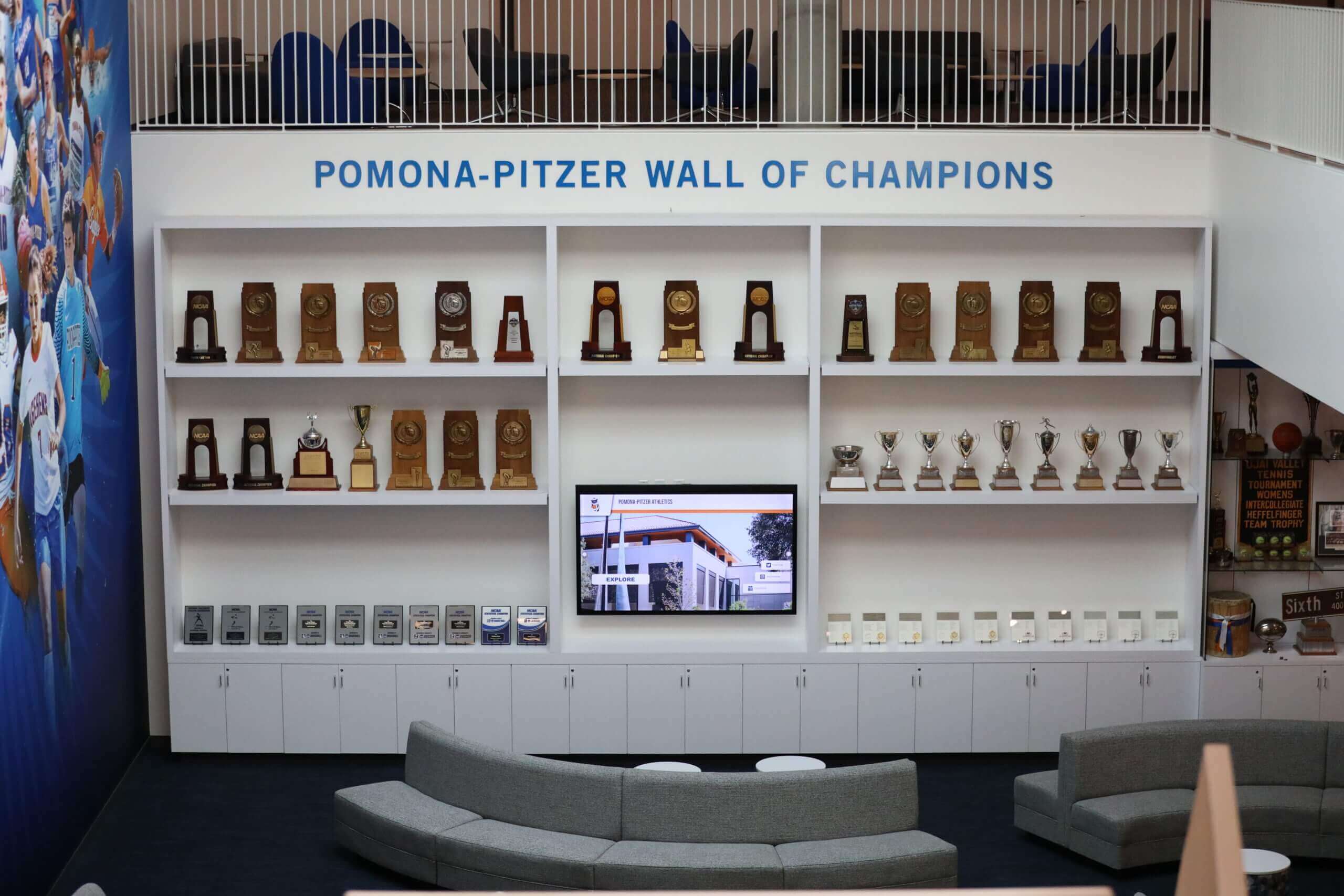
Average Gift Size and Upgrade Rates
Beyond participation improvements, effective recognition programs drive notable increases in contribution amounts through multiple psychological mechanisms:
Gift Size Impact:
- 18-27% increase in average gift amounts from recognized donors
- 30-45% improvement in upgrade rates to higher giving societies
- 2-3x higher likelihood of major gifts ($25,000+) from alumni featured in premium recognition
- Significantly larger planned giving commitments from donors receiving lasting legacy recognition
Upgrade Motivation Factors:
The clear visibility of different giving tiers and recognition levels creates natural upgrade motivation. When donors see the enhanced acknowledgment available at higher contribution levels—expanded profiles, video testimonials, premium placement, special events—many aspire to reach those thresholds. Digital displays make tier differentiation visible in ways generic thank-you letters cannot, creating aspirational targets that inspire stretch giving.
Additionally, seeing cumulative giving progress toward next recognition thresholds motivates donors to increase contributions. Systems displaying “you’ve contributed $4,200 toward our $5,000 Champion Society threshold” provide concrete targets that encourage gift increases to reach meaningful milestones.
Donor Retention and Lifetime Value
Perhaps most significantly, effective recognition programs dramatically improve donor retention rates—the percentage of contributors who make repeat gifts. Because acquisition costs far exceed retention expenses, even modest retention improvements generate substantial lifetime value increases.
Retention Impact Documentation:
- First-Time Donor Retention: 35-45% improvement in second-gift rates (from typical 20-25% baseline to 30-35%)
- Multi-Year Retention: 15-25 percentage point improvements in 3-year and 5-year retention rates
- Lapsing Prevention: 40-50% reduction in donor attrition during years 2-5 of giving relationships
- Lifetime Value Growth: 25-75% increases in projected donor lifetime value across all giving segments
Return on Investment Calculations:
For an institution with 10,000 contactable alumni and 10% baseline giving participation:
Without Recognition Program:
- 1,000 donors × $250 average gift = $250,000 annual revenue
- 40% retention = 400 repeat donors + 600 new to replace lapsed = $250,000 year 2
- 5-year cumulative: ~$1,250,000
With Digital Recognition Program:
- Year 1: 1,150 donors × $275 average = $316,250 (recognition investment ~$35,000)
- Year 2: 60% retention + replacement = 1,200 donors × $295 average = $354,000
- 5-year cumulative: ~$1,850,000
Net Benefit: $600,000 additional revenue over 5 years on $35,000 investment = 17:1 ROI
These financial returns explain why sophisticated advancement operations view recognition not as expense but as high-ROI fundraising infrastructure warranting substantial investment. For more on measuring returns, explore research on advanced analytics for recognition.
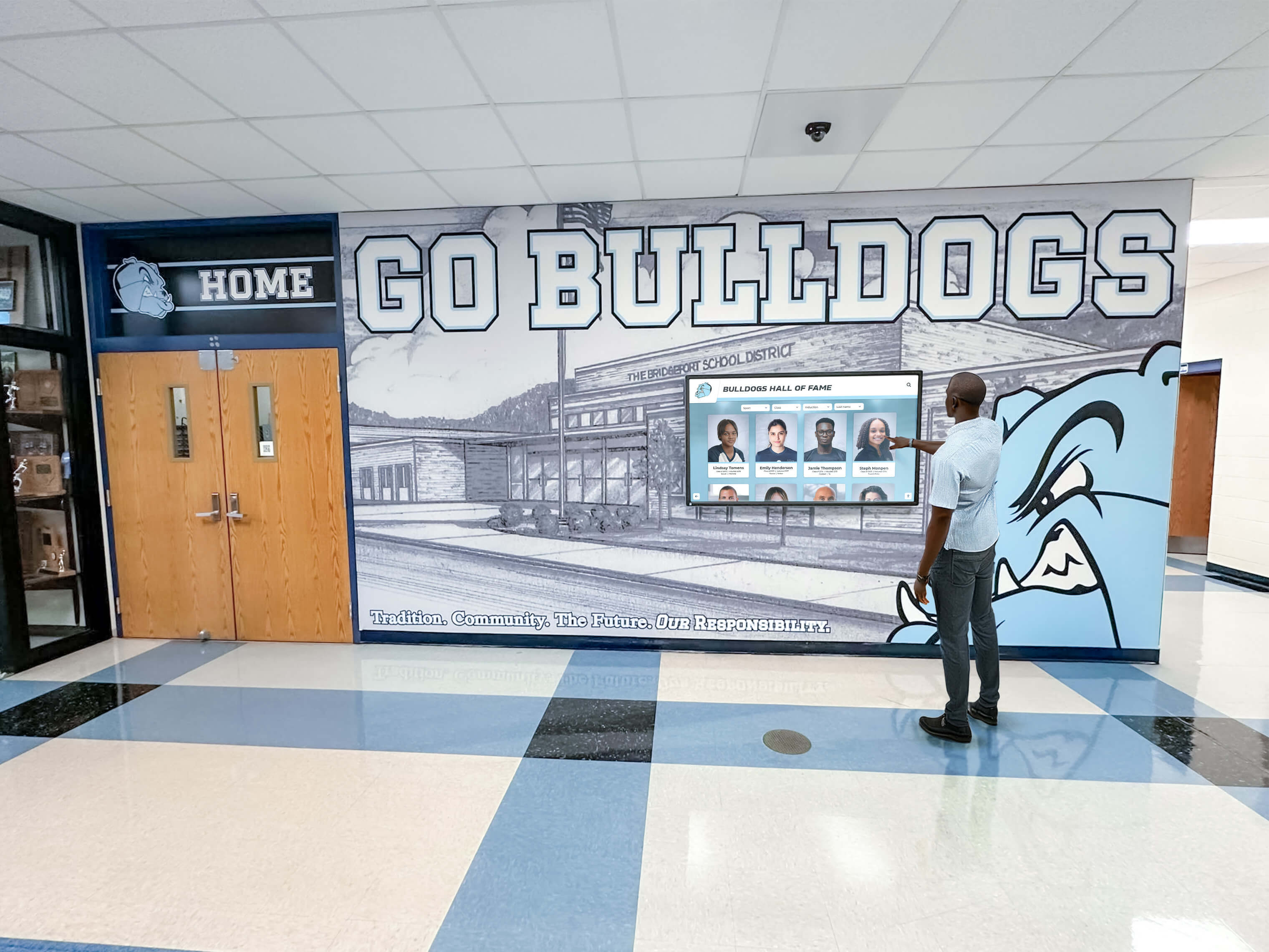
Implementation Best Practices: Setting Your Program Up for Success
Understanding recognition’s fundraising impact and psychological foundations matters little without effective implementation. These proven practices help institutions maximize recognition program outcomes:
Best Practice 1: Establish Clear Recognition Criteria and Giving Tiers
Successful programs define transparent selection standards and giving level structures before launching recognition systems. Clear criteria prevent confusion, ensure perceived fairness, and help donors understand acknowledgment opportunities at different contribution levels.
Essential Tier Structure Components:
Sample Tiered Recognition Framework
| Recognition Level | Giving Range | Recognition Benefits |
|---|---|---|
| Friend | $100 - $499 | Name listing on digital honor wall, annual report inclusion |
| Supporter | $500 - $999 | Above plus basic profile with photo, special event invitations |
| Advocate | $1,000 - $2,499 | Above plus enhanced profile with biographical narrative, giving society membership |
| Champion | $2,500 - $4,999 | Above plus featured home screen rotation, leadership recognition events |
| Patron | $5,000 - $9,999 | Above plus video testimonial opportunity, premium profile placement |
| Benefactor | $10,000+ | Comprehensive premium recognition including personal leadership engagement, naming opportunities |
Note: Adjust ranges based on institutional size, fundraising goals, and donor base capacity. Some schools use cumulative lifetime giving while others recognize single gift amounts.
This tier clarity helps donors understand exactly what recognition different contribution levels provide, creating transparency that builds trust while motivating stretch giving to reach higher acknowledgment thresholds.
Best Practice 2: Invest in High-Quality Content Development
Technology enables recognition, but compelling content creates emotional engagement that drives giving motivation. Institutions achieving strongest results prioritize content quality over technology features, recognizing that mediocre stories displayed through sophisticated systems generate worse outcomes than compelling narratives presented simply.
Content Excellence Requirements:
- Professional Photography: High-resolution portraits and candid photos capturing personality and institutional connection
- Biographical Depth: 200-800 word narratives providing context about donors, their motivations, institutional relationships, and giving journeys
- Video Testimonials: 2-4 minute interviews with donors explaining why they support the institution (for premium recognition levels)
- Impact Documentation: Specific stories connecting gifts to tangible outcomes—scholarships awarded, facilities built, programs launched
- Authentic Voice: Content using donors’ own words rather than institutional marketing language
- Regular Enhancement: Systematic processes for updating profiles with career changes, new accomplishments, or additional giving
Many institutions underestimate content development effort and timeline. Comprehensive profile development typically requires 40-60 hours per 50 donor profiles for initial launches, with ongoing maintenance requiring 2-4 hours monthly. Planning adequate resources for content excellence separates recognition programs that generate strong engagement from those that become underutilized technology installations.
For detailed guidance on content development, explore resources on college recruitment and recognition strategies.
Best Practice 3: Position Displays in Strategic High-Traffic Locations
Even excellent recognition generates minimal impact if positioned in locations few people encounter. Strategic placement ensures maximum visibility among target audiences—visiting alumni, prospective donors, current students who become future givers, and community members who influence institutional reputation.
Optimal Display Locations:
- Main Building Lobbies: Primary entrances where all campus visitors naturally pass
- Advancement Office Areas: Spaces where major gift prospects visit for cultivation meetings
- Athletic Facilities: Gymnasiums, stadiums, field houses serving as alumni gathering points during competitions and events
- Student Centers: High-traffic commons areas ensuring current student exposure to alumni success
- Alumni Center Entrances: Dedicated advancement spaces where recognized donors frequently visit
- Event Venues: Locations hosting fundraising galas, reunions, and donor appreciation gatherings
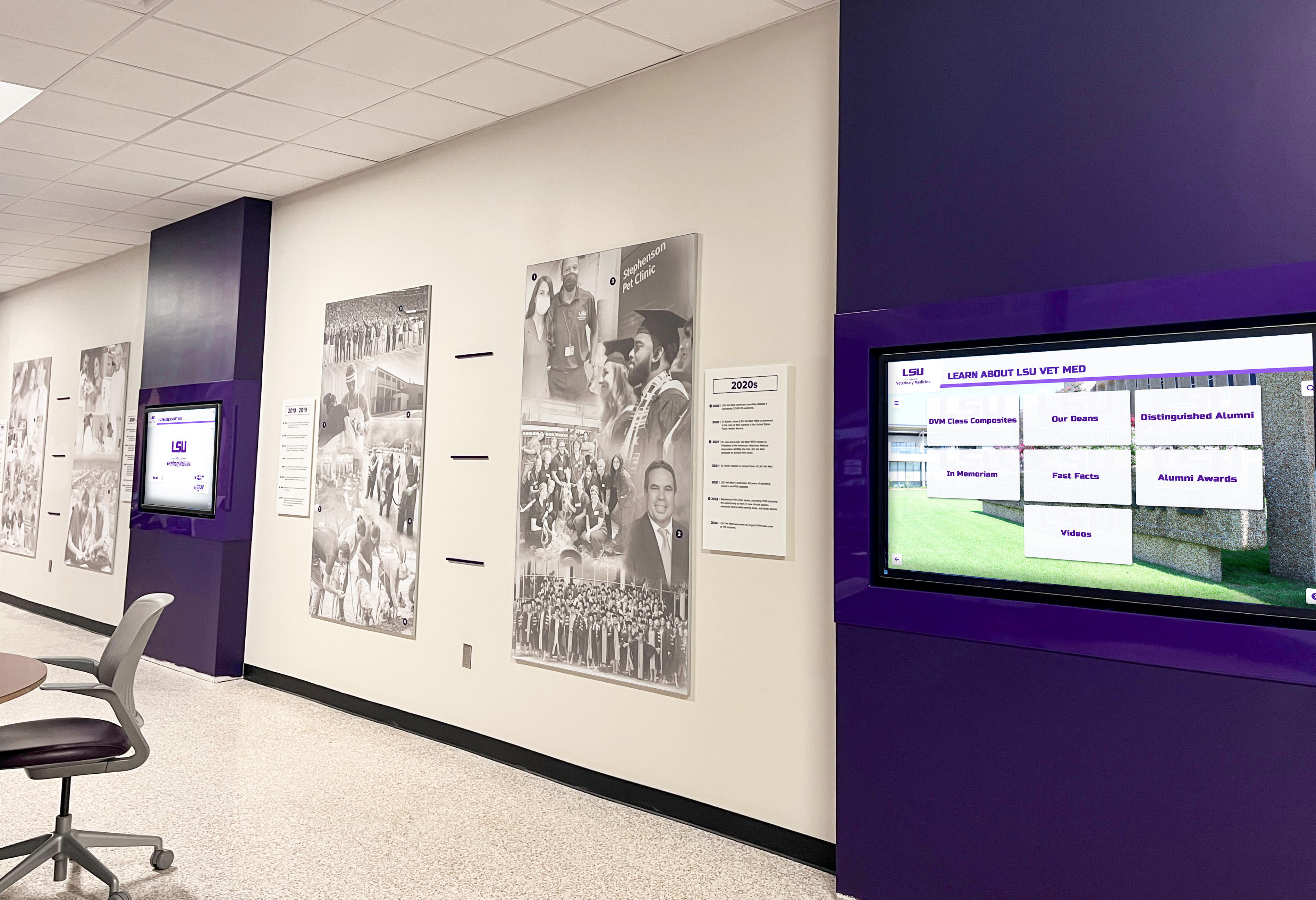
Placement Considerations:
- Sightlines and Visibility: Ensure displays are visible from primary circulation paths without requiring visitors to seek them out
- Lighting Conditions: Avoid locations with excessive glare from windows or inadequate ambient lighting
- Accessibility Compliance: Position displays at appropriate heights with clear approach space meeting ADA requirements
- Multiple Installation Strategy: Consider deploying recognition network across several strategic locations rather than single comprehensive display
Best Practice 4: Create Sustainable Management Workflows
Recognition program effectiveness depends on sustainable operations ensuring timely updates, content currency, and system reliability across years or decades. Institutions achieving long-term success establish clear workflows, designate responsible staff, and implement systems enabling efficient ongoing management.
Essential Operational Elements:
Clear Ownership
Designate specific staff members (typically 1-2 advancement team members) as recognition program managers with clear responsibilities
Update Workflows
Establish documented processes for adding new donors, updating existing profiles, and maintaining content accuracy
Content Calendar
Create publishing schedules for featured donor rotations, impact story additions, and campaign progress updates
Quality Standards
Document content requirements including photo resolution, biography length, fact-checking procedures, and approval workflows
Technical Support
Establish vendor relationships or IT support ensuring reliable system operation, troubleshooting, and updates
Performance Review
Schedule quarterly analytics reviews to assess program effectiveness, identify optimization opportunities, and demonstrate ROI
Programs treating recognition as ongoing strategic initiative rather than one-time project achieve dramatically better long-term results. For comprehensive implementation guidance, review resources on school recognition programs.
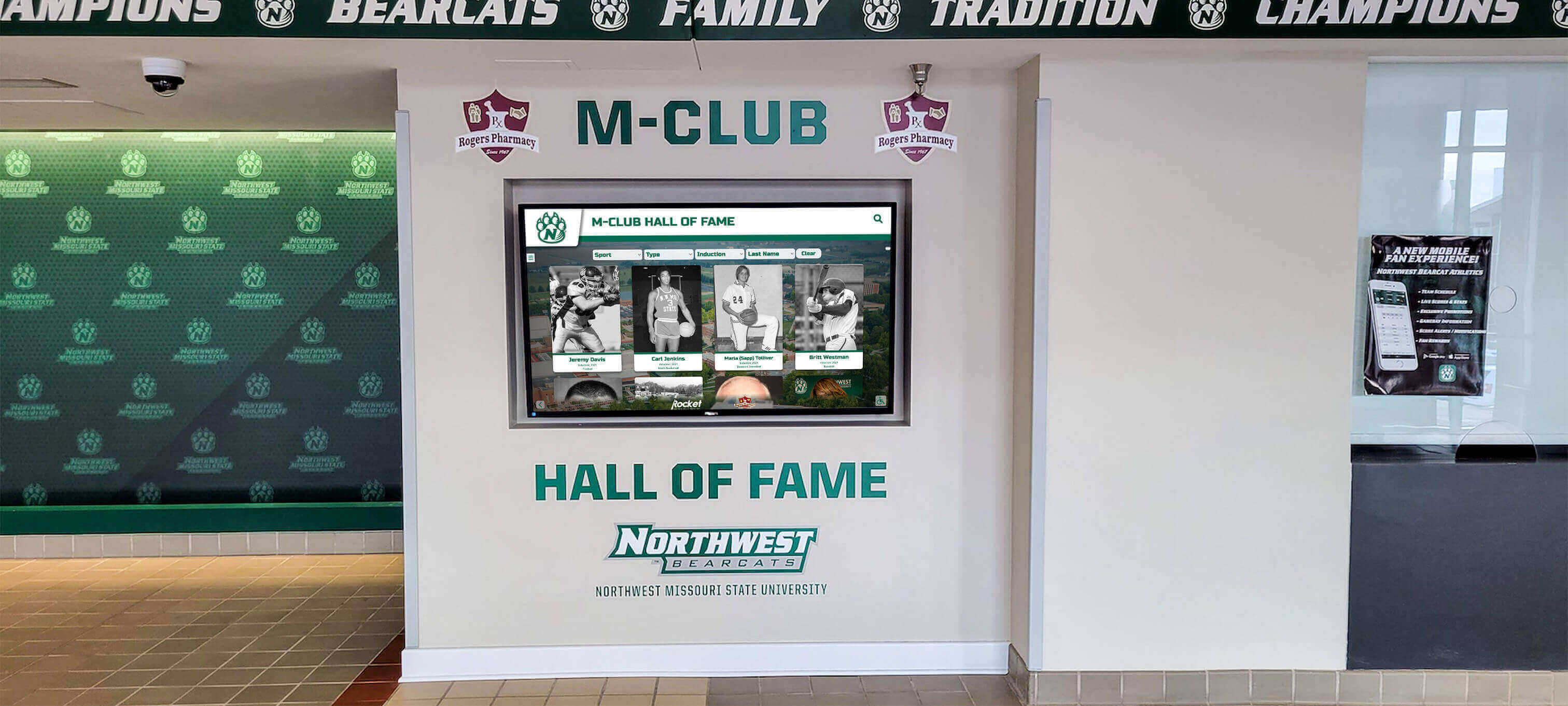
Overcoming Common Implementation Challenges
Institutions implementing digital recognition programs encounter predictable obstacles that proven solutions address effectively:
Challenge 1: Limited Historical Information and Budget Constraints
Many schools discover incomplete historical records for past alumni, while budget limitations affect implementation scope and timeline.
Solution Approaches:
- Phased Implementation: Launch with well-documented recent alumni, systematically expanding backward through decades as resources permit
- Alumni Contribution Campaigns: Invite recognized alumni to submit photos, biographical information, and personal statements rather than staff developing all content
- Crowdsourcing Historical Content: Engage reunion classes, alumni associations, and volunteers in research projects that become engaging community activities
- Flexible Recognition Tiers: Design entry-level acknowledgment requiring minimal content (name, year, giving level) with enhanced profiles as optional for those providing additional information
- Long-Term ROI Focus: Present comprehensive business cases demonstrating how increased giving participation and retention justify initial recognition investments through 2-3 year payback periods
Challenge 2: Technology Selection and Change Management
Choosing appropriate systems and managing organizational change require careful attention to avoid common pitfalls.
Solution Strategies:
- Purpose-Built Platforms: Select recognition-specific systems like those from Rocket Alumni Solutions designed specifically for educational advancement rather than adapting generic digital signage requiring extensive customization
- Comprehensive Vendor Support: Work with providers offering implementation assistance, content development guidance, staff training, and ongoing technical support rather than technology-only vendors
- Change Communication: Develop comprehensive communication plans explaining recognition program benefits to stakeholders—board members, faculty, staff, and alumni
- Gradual Rollout: Consider soft launches with select stakeholder groups before full public deployment, enabling refinement based on early feedback
- Training Investment: Provide thorough staff training on content management systems, ensuring confidence and competence that supports long-term program sustainability
Challenge 3: Maintaining Long-Term Engagement and Relevance
Initial launch excitement naturally fades without strategic attention to sustained program vitality and relevance.
Sustainability Approaches:
- Regular Content Additions: Establish quarterly or bi-annual cycles for adding newly recognized donors, maintaining currency that demonstrates active fundraising momentum
- Featured Content Rotation: Change homepage spotlights monthly, creating reasons for repeat visits and ensuring all recognition levels receive premium visibility over time
- Event Integration: Prominently feature recognition displays during reunions, homecoming, galas, and fundraising events when alumni engagement peaks
- Social Media Amplification: Regularly share recognition content through institutional social channels, extending visibility beyond campus while driving traffic to displays and web platforms
- Annual Induction Ceremonies: Create special events celebrating new recognition additions, generating publicity while honoring contributors through memorable experiences
- Analytics-Informed Optimization: Use engagement data to understand what content resonates, which features get used, and how visitors interact—continuously improving based on actual behavior rather than assumptions
For additional guidance on avoiding implementation mistakes, review resources on common recognition installation errors.
Conclusion: Transform Recognition Into Strategic Fundraising Asset
Digital recognition displays represent far more than modern alternatives to traditional plaques—they function as sophisticated fundraising infrastructure creating psychological motivation, social proof, and emotional connections that inspire sustained alumni philanthropy. The evidence proves compelling: institutions implementing strategic digital recognition programs consistently achieve 15-25% participation increases, significantly improved donor retention, and measurable ROI within 18-24 months.
Success requires viewing recognition not as afterthought acknowledgment but as strategic advancement priority worthy of thoughtful planning, adequate investment, quality content development, and ongoing optimization. The most effective programs share common characteristics: they honor donors at all giving levels through unlimited-capacity systems, tell compelling stories connecting gifts to tangible impact, create interactive experiences inviting personal discovery and exploration, integrate physical and digital recognition across multiple touchpoints, and maintain content currency that demonstrates institutional vitality and fundraising momentum.
The choice between continuing traditional recognition approaches or embracing digital innovation increasingly appears straightforward as evidence accumulates demonstrating technology’s fundraising advantages. Traditional methods serve institutions satisfied with status quo participation rates, comfortable with donor attrition requiring constant replacement acquisition, and content with static acknowledgment reaching small fractions of alumni bases.
Digital recognition serves institutions committed to transforming alumni engagement, determined to maximize donor lifetime value through improved retention, and focused on creating recognition experiences that justify donors’ generosity while inspiring others to join philanthropic communities.
For schools and universities ready to leverage recognition as strategic fundraising asset rather than administrative obligation, solutions like Rocket Alumni Solutions provide comprehensive platforms combining proven technology, implementation support, content development guidance, and ongoing technical assistance. These specialized systems eliminate compromises required when adapting generic tools while ensuring recognition programs achieve engagement objectives without overwhelming institutional resources.
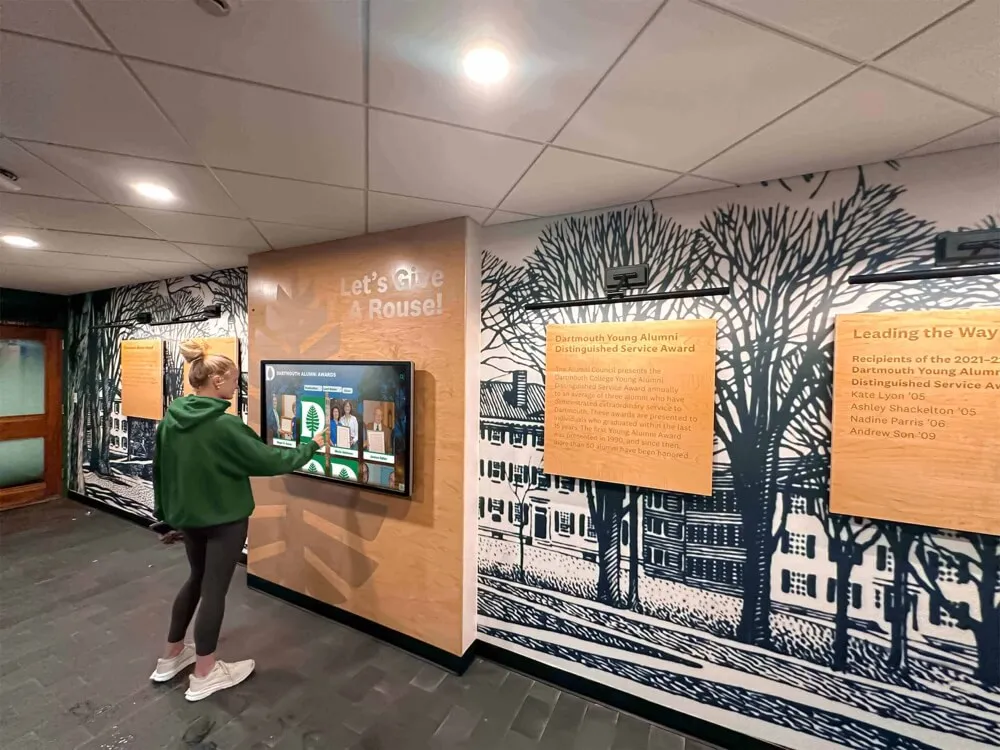
Your alumni have chosen your institution from countless alternatives, investing time, resources, and trust in educational experiences that shaped their lives. They deserve recognition that honors their achievements appropriately while inspiring the sustained philanthropic support that enables your school to serve future generations. Digital displays transform this recognition from passive acknowledgment into active engagement that strengthens relationships, demonstrates impact, and creates lasting communities of support.
By implementing strategic digital recognition programs informed by psychological research, proven by measurable outcomes, and sustained through systematic operations, educational institutions build philanthropic cultures where giving becomes celebrated norm rather than occasional exception—transforming alumni relationships into lasting partnerships that advance institutional missions for decades to come.
Ready to Transform Your Alumni Recognition and Fundraising?
Discover how interactive digital recognition displays can increase giving participation, improve donor retention, and create lasting alumni engagement. Visit Rocket Alumni Solutions to explore comprehensive recognition platforms designed specifically for educational advancement, or learn more about donation honor walls and digital recognition best practices. With proven results across hundreds of institutions, strategic digital recognition transforms how schools inspire alumni to give back.
Start planning your recognition program today—schedule a consultation to discover how digital displays can strengthen your advancement outcomes while honoring the alumni who make institutional excellence possible.
